
The technologies behind what make our product one of the best greenhouse options on the market are not rocket science. They are Dome science! You might already be familiar with our seven features, but if not we are going to get down to the basics so that you can understand how they work and why they make the Growing Dome Greenhouse the best greenhouse option for you!
- Dome Science 101: Heat Transfer
- The Above Ground Pond and Thermal Mass
- Geodesic Shape and Energy Efficiency
- Greenhouse Covering and Light Transmission
- Insulated Foundation Wall
- North Wall Insulation
- Automated Ventilation:
- Undersoil Ventilation System Ties Everything Together!
- There you have it! Dome science.
Dome Science 101: Heat Transfer
Let’s start with the basics. There are three basic ways that heat is transferred within the Growing Dome and just in general; conduction, convection, and radiation. You probably remember these terms from science class, but it has been a while for most of us. Here is a little refresher!
- Conduction is heat transfer via contact.
- Convection is the transfer of heat via the movement of a fluid (liquid or gas).
- Radiation is heat transfer by electromagnetic waves through empty space.
The thermal energy from the sun travels to Earth, where it finds your greenhouse, and gets trapped. This is how most greenhouses work, by trapping the heat of the sun, but we have taken it a few steps further with some added Dome science.
The Above Ground Pond and Thermal Mass
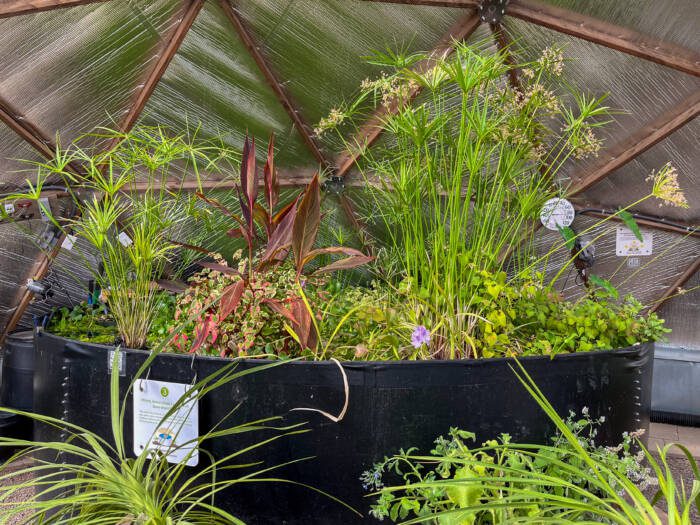
The above ground pond is made out of sheet metal, a good conductor, and painted a black or a dark color. The color of the pond matters because a black object is going to absorb the thermal rays of the sun whereas a light color will actually reflect it. Absorption of thermal rays means that the temperature will increase! That heat will then be transferred to the water in the pond via conduction.
This is where the idea of thermal mass comes in. Thermal mass is the ability of a material to absorb, store, and release heat. Water has a high specific heat making it great at absorbing heat and it has three times the thermal storage capacity of concrete. In the winter time the water in the pond is going to be warmer than the air around it. Therefore the heat will be transferred from the water to the air making it feel warmer in the Growing Dome. In the summer the temperature of the water will be cooler than the air within the Dome, so it will create a cooling effect.
Geodesic Shape and Energy Efficiency
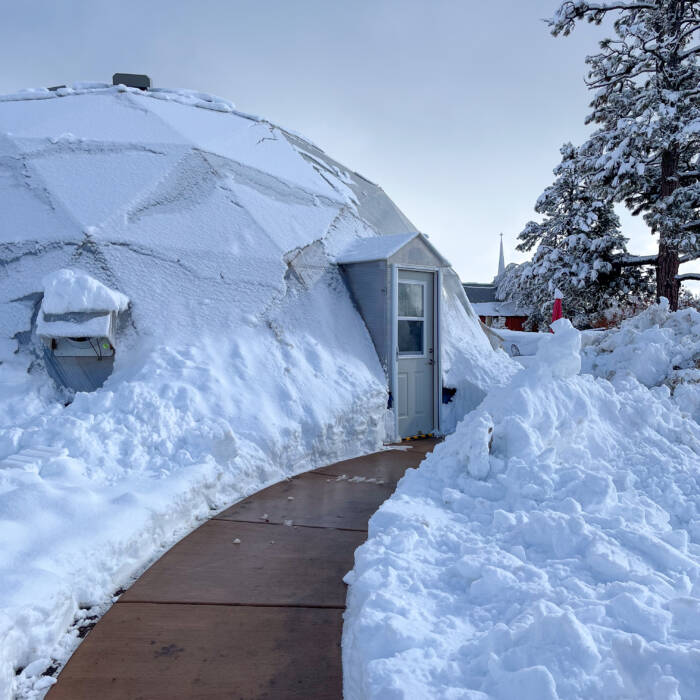
Compared to a traditional greenhouse, the Growing Dome’s geodesic shape has minimal surface area for the amount of square footage. There is a large volume of air compared to the external surface area making it less impacted by the heat of the summer and cold of winter. This also means that it requires less energy to heat in the winter and cool in the summer.
Our Domes do not require supplemental heat to work properly in the winter as long as you are planting cold hardy crops. However, if you live in more northern climates where you experience less sunlight during the day, or if you have consecutive cloudy days in a row, you may choose to add heat. Remember what we talked about earlier with the sun and the pond, that’s why these two cases may require heat.

Conversely, if you live in a more southern climate you may decide to add some type of cooling system like a swamp cooler or air conditioning unit to help cool the Dome in the heat of the summer. Keep in mind that “hot” for plants is different than “hot” for humans. Most plants can tolerate temperatures up to 104 degrees Fahrenheit before displaying signs of stress. Whereas, put me in a 80 degree greenhouse for more than 5 minutes and I need a popsicle and a cold glass of lemonade. STAT!
If you do find you need to add heating or cooling, you will be using far less energy than you would in a traditional rectangular greenhouse or hoop house.
Greenhouse Covering and Light Transmission
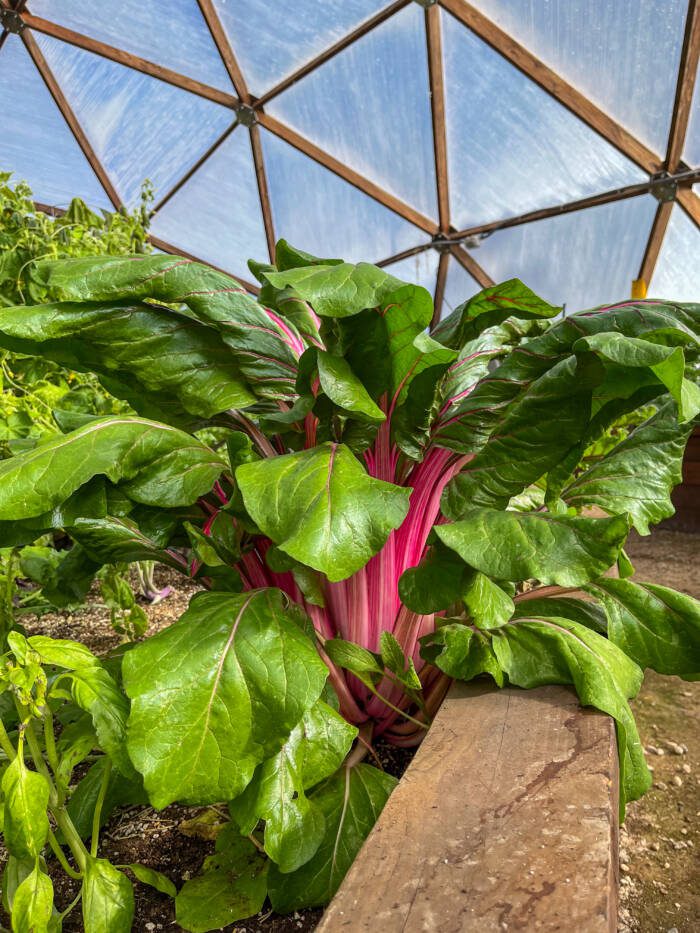
Polycarbonate! In our opinion polycarbonate is the best greenhouse covering on the market. Why? It is going to protect your crops from extreme weather conditions and provide a nice diffused light that your plants will love. Plus it actually has an R-value, or insulation value, of 2.8. That might not seem like much, but every little bit counts. Most greenhouse plastics have an R value of .85 and even if you double line the greenhouse with an air gap in between, you will only increase the insulation to about 1.25.
The 5-wall polycarbonate that comes standard with our Domes allows for 65% light transmission. What does that mean? It means that your plants will not be scorched by the sun and that they will be less likely to bolt. Too much direct sun exposure can also cause plants to prematurely bolt, or go to seed, which prevents them from yielding a bountiful harvest. The polycarbonate will also limit the amount of UV rays that reach your plants. Much like humans, plants can get burnt if exposed to too much UV light. Unlike humans, plants don’t have the ability to put on sunscreen. Therefore they appreciate the extra protection.
The polycarbonate also comes with a 10 year manufacturer warranty against yellowing and hail damage!
Insulated Foundation Wall
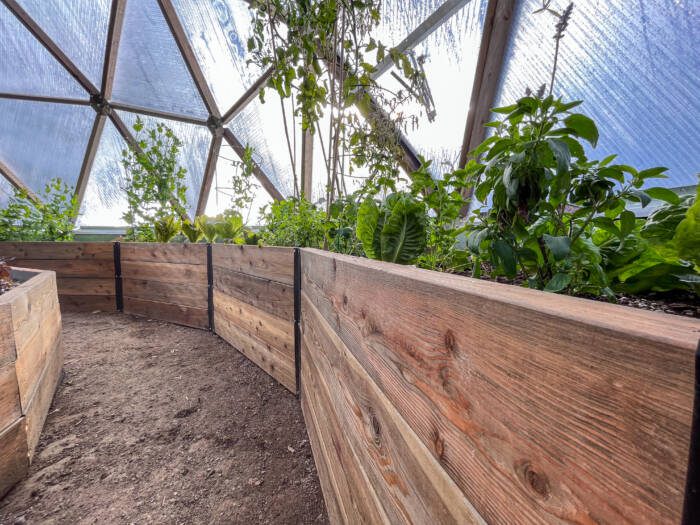
What is so special about our two-foot all weather wood insulated foundation wall? Well, many traditional greenhouses don’t have one. This wall does a couple of things. Number one your back and knees will thank you for having your garden beds two feet above the ground due to less bending and kneeling.
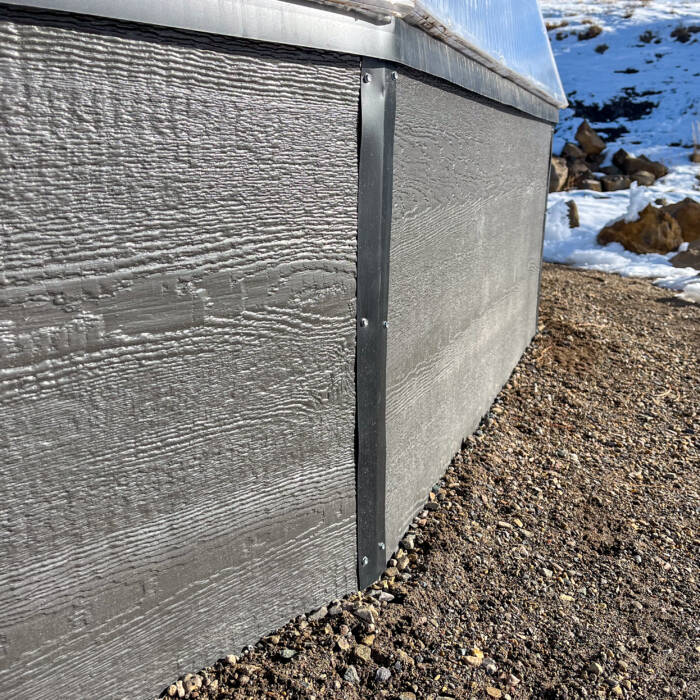
Number two, and more noteworthy in this conversation, is insulation! The foundation wall is similar to the walls that you have in your home in the sense that it consists of a top and bottom plate with studs in between. The gaps between these studs create a cavity where we can add insulation. We recommend using a rigid foam for ease and convenience. This rigid foam is one of the owner supplied items for our kits as it is bulky and would be extremely costly to ship. We also provide you with a couple of cans of spray foam to fill in any large gaps between the rigid foam and wall studs.
North Wall Insulation
The north wall insulation is reflective for a very good reason! In the winter, when the sun is lower on the horizon this will reflect the thermal rays back into your Growing Dome keeping it warm. In the summer, when the sun is higher on the horizon it will help to provide shade to your pond while simultaneously reflecting the sun’s rays away from your greenhouse. That’s what we like to call a twofer, two for one. It also provides a bit of added insulation to help with heat loss or gain depending on the season.
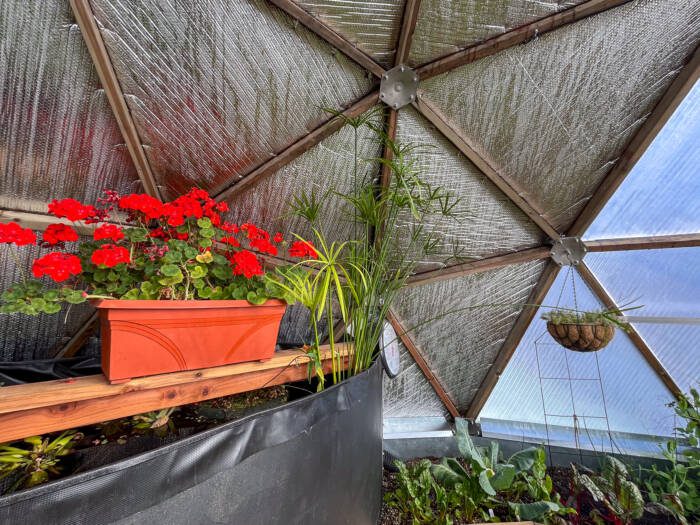
The polycarbonate, reflective north wall insulation, and the foundation wall are creating an insulating barrier so that we can maximize the inherent energy efficiency of the Dome shape.
Automated Ventilation:
Passive Air Flow
All of our Growing Domes come standard with some form of automated ventilation system. Remember that convection is the transfer of heat via the movement of a fluid. Convection is what creates the chimney effect within the Growing Dome. Hot air rises because it is less dense than cooler air. Due to the Dome shape, there is no corner for hot or cold air to hide!
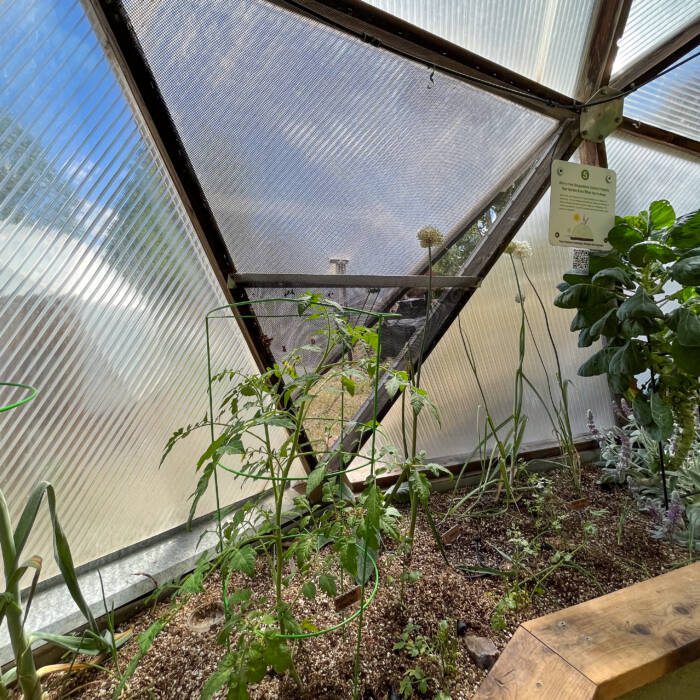
The smaller and medium-sized Domes come with passive ventilation in the form of vents. There are lower and upper vents that are controlled using a temperature-sensitive vent opener. When the internal temperature of your Dome reaches about 65 degrees Fahrenheit, the vents will open. Your upper vents will open first because hot air rises. Then once the lower vents open, they will allow for cooler air to enter the Dome. As that cooler air warms up, it will escape out the top.
Active Air Flow
Our larger Domes do come standard with fans for active ventilation. This is because the increased volume of air requires a bit of extra help to get things moving, so active ventilation is the way to go. We have intake fans in the lower portion of the Dome, pulling in cooler air, and exhaust fans at the top, pushing the hot air out. Same concept of the chimney effect, but with a little boost. We do have a standard number of fans that comes with the 26’, 33’ and 42’ Domes, but you can always add more. We also have fan options for all sizes of Domes, if you want to give yours some active ventilation.
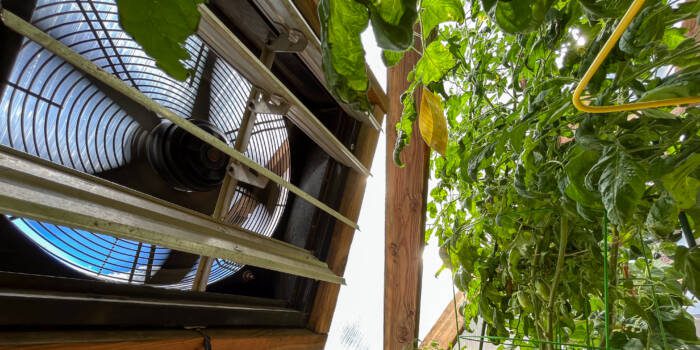
What you want to keep in mind is that your intake and exhaust should be about equal, so you will need to do some simple math regarding the CFMs of each fan. CFM stands for cubic feet per minute. A cubic foot is about the size of a basketball, so how many basketballs of air is that fan moving per minute? We have a handy dandy air exchange calculator for you to use!
Undersoil Ventilation System Ties Everything Together!
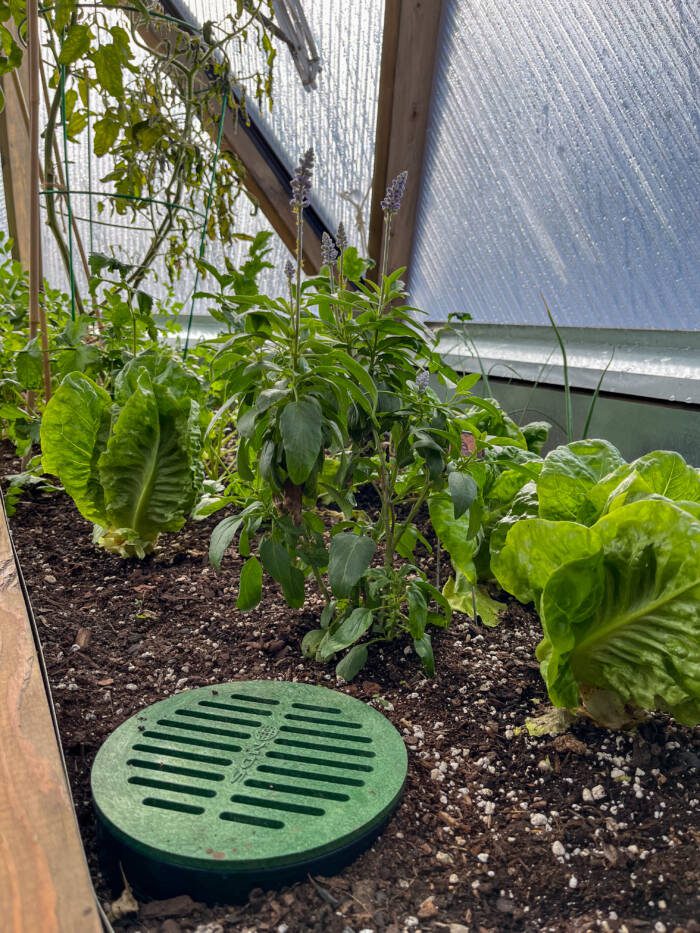
Our undersoil ventilation system moves the air from around your above-ground pond through the soil of your perimeter beds and out to the southern side of the Dome. Due to the above-ground pond, the air on the north side of the Dome will be the most consistent temperature. In comparison, the southern side is going to experience more extremes. By moving the air from the north to the south, we are creating more regulated temperatures throughout the Growing Dome.
In the winter this system is handy because it helps to warm the soil which makes your plants have happy roots! Happy roots make your plants less susceptible to disease and pests and can also lead to increased yield.
There you have it! Dome science.

The only greenhouse on the market that makes sense. A greenhouse of any kind is going to be an investment, but a Growing Dome can recoup your initial investment in 3 ½ years time. With our current economic situation and food prices skyrocketing, you might be able to make it back even quicker than that. You can use our ROI calculator to see for yourself!
